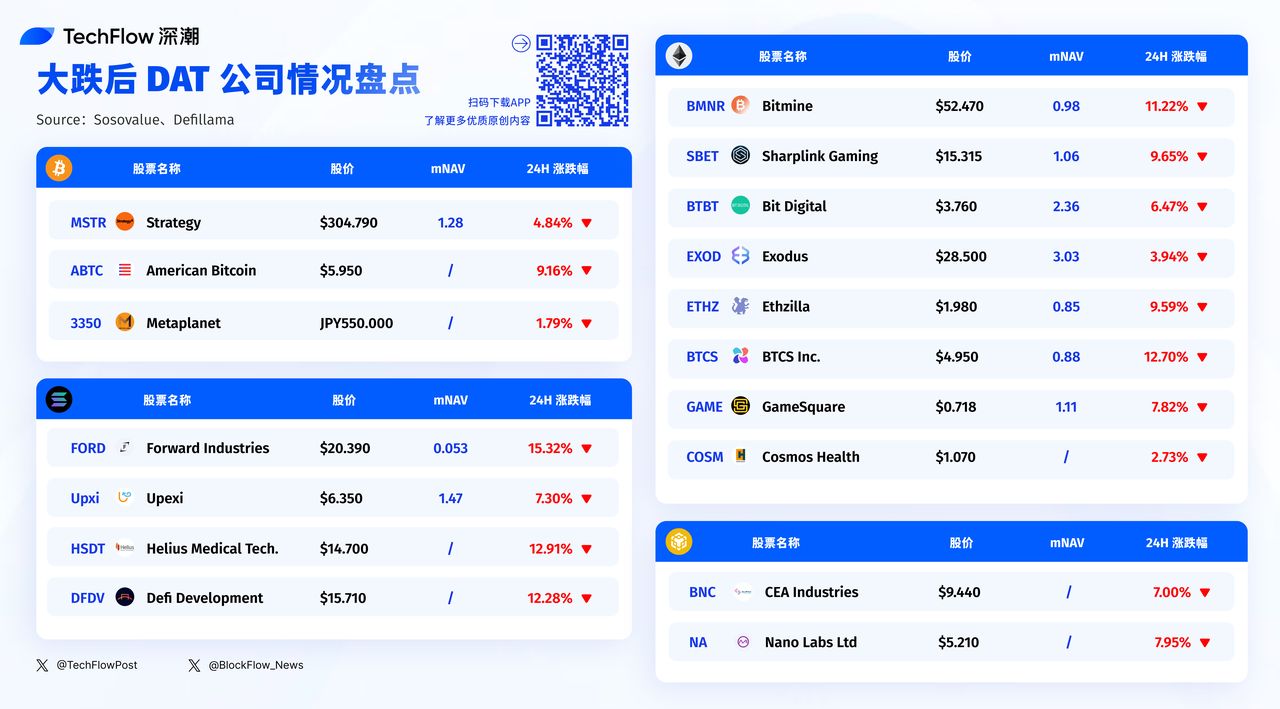Why did DAT's stock price lead the decline during the crypto crash?
Author: David, Deep Tide TechFlow
Original Title: After the Crypto Crash, Are DAT Companies' Stocks Still Okay?
On the afternoon of the 10th, President Trump announced on Truth Social a 100% tariff on Chinese goods. This news instantly ignited panic across global financial markets.
In the following 24 hours, the cryptocurrency market experienced the largest liquidation event in its history, with over $19 billion in leveraged positions forcibly closed. Bitcoin plummeted from $117,000, briefly falling below $102,000, with a daily drop of over 12%.
The US stock market was not spared either. At the close on October 10th, the S&P 500 index fell by 2.71%, the Dow Jones Industrial Average dropped by 878 points, and the Nasdaq Composite Index fell by 3.58%, all marking the largest single-day declines since April.
However, the real disaster zone was the DAT (Digital Asset Treasury) companies that hold crypto assets as treasury reserves.
As the largest corporate bitcoin holder, MicroStrategy's stock price was not spared either; other crypto asset reserve companies saw even more pronounced plunges. According to after-hours trading data, investors continued to sell off.
For these companies exposed to both the crypto and stock markets, has the worst already passed?
Why Did DAT Companies Fall Even Harder?
The first challenge DAT companies face is the direct impact on their balance sheets. Take MicroStrategy as an example: the company holds about 639,835 bitcoins. When bitcoin's price drops by 12%, it means nearly $10 billion in asset value evaporates instantly.
Such losses must be recorded as "unrealized losses" under accounting standards. Although it isn't a real loss unless sold, the numbers on the financial statements are very real.
As an investor, what you see is a company's core assets rapidly depreciating. There is also a multiplier effect regarding market confidence.
At the beginning of 2025, MicroStrategy's stock net asset value (NAV) premium was as high as 2x, but by the end of September, it had compressed to 1.44x; currently, it's around 1.2.
For some other companies, mNAV is almost returning to 1, and some have even fallen below 1. These changes reflect a harsh reality: confidence in the DAT model is wavering in extreme market conditions.
In a bull market, investors are willing to give these companies a premium, with the narrative being pioneers of crypto innovation. But when the market turns, the same story becomes an unnecessary risk exposure.
Non-bitcoin cryptocurrencies suffered huge technical damage in this round of leverage-induced crash, with some even instantly dropping to zero; even large-cap altcoins saw their prices halved or worse due to insufficient liquidity.
And the stocks of companies holding these assets became the preferred short targets as market sentiment deteriorated.
When panic strikes, investors need to reduce their positions quickly. While the bitcoin market trades 24/7, large sell orders can severely impact prices. In contrast, selling stocks like MSTR on Nasdaq is much easier.
Selling hundreds of billions of dollars in gold won't disrupt the market, but selling $70 billion in bitcoin could cause a price collapse and trigger mass liquidations; this liquidity difference makes DAT company stocks a quick exit channel for funds.
Worse still, many institutional investors have strict risk control thresholds. When volatility exceeds a certain level, they must reduce their positions, whether they want to or not. And DAT companies are among the most volatile targets.
To use an inappropriate analogy, if ordinary tech companies are sitting in one boat, DAT companies are like tying two boats together—one sailing in the stock market, the other struggling in the crypto market.
When both sides encounter bad weather at the same time, the impact they endure is not additive, but multiplicative.

Who Suffered Most, Who Was Most Resilient?
Looking at the DAT companies' biggest losers from the previous trading day, you can clearly see a pattern: the smaller the company, the harder it fell.
Forward Industries dropped 15.32%, with an mNAV of only 0.053. BTCS Inc. fell 12.70%, Helius Medical Tech dropped 12.91%.
These companies, with market caps of less than $100 million, could hardly find buyers in the panic. In contrast, although MicroStrategy is the largest bitcoin holder, its drop was only 4.84%.
The logic behind this is simple: liquidity.
When panic hits, the bid-ask spread for small-cap stocks widens sharply, and a slightly larger sell order can crash the stock price.
For relatively larger DATs, MicroStrategy's mNAV is only 1.28x, almost trading at its bitcoin holding value. The market values these companies basically at their crypto asset value plus a slight premium. When the crypto market crashes, they have no other business to cushion the blow.
When a company's market cap is almost equal to the value of its crypto holdings (mNAV close to 1), it means the market believes the company has no added value beyond hoarding coins.
Bitmine's mNAV is 0.98, and other companies without precise mNAV data are estimated to be similarly low. These companies have essentially become crypto ETFs in the guise of listed companies.
The question is, now that there are real bitcoin ETFs to buy, why would investors still indirectly hold through these companies?
This may explain why, in a panic, these low-mNAV companies fall even more. They bear both the risk of crypto assets and the stock market, yet provide no additional value.
The US stock market will open in a few hours. After a weekend cooling-off period, will market sentiment improve? Will those small DAT companies that fell more than 10% continue to be sold off, or will bargain hunters step in?
From the data, companies with mNAV below 1 may present oversold opportunities, but could also be value traps. After all, when a business model itself is being questioned, cheapness may not be a reason to buy.
Disclaimer: The content of this article solely reflects the author's opinion and does not represent the platform in any capacity. This article is not intended to serve as a reference for making investment decisions.
You may also like
From "President's Son" to "Teenage Tycoon": Barron Trump's First Pot of Gold


Trump holds $870 million in Bitcoin! Will the tariff war cause the market to crash?

PENGU Gears Up for a Comeback as Bulls Defend $0.022

